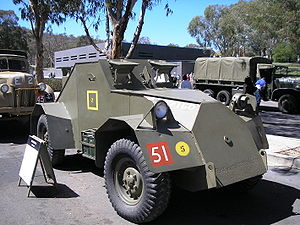- Dingo (scout car)
-
Dingo Scout Car
A Dingo Scout CarType Armoured car Place of origin  Australia
AustraliaProduction history Number built 245 Specifications Weight 4.5 tonnes Length 4.6 m Width 2.1 m Height 1.9 m Crew 2 (Commander, Driver) Armour Front 30 mm, sides and rear 10 mm Main
armament0.303 (7.7 mm) Bren Light machine gun Engine Ford V8
85 or 95 hp (63.5 or 71 kW)Power/weight 19 or 21 hp/tonne Suspension wheel 4x4, leaf spring Operational
rangekm Speed 90 km/h This article is about the Australian armoured car. For the British reconnaissance vehicle, see Daimler Dingo. For the modern German infantry mobility vehicle, see ATF Dingo.The Dingo Scout Car was a light armoured car built in Australia during Second World War. They were produced by the Ford motor company during 1942.
Contents
History
Australia was unprepared for World War II and possessed little in the way of armoured vehicles, and being unable to purchase them from their traditional supplier, the United Kingdom whose industrial output was dedicated to more immediate needs in Europe, it was forced to try to develop and build them itself, and armoured cars and scout cars were no exception.
The Dingo was based on a commercial Ford 30-cwt 134.5 inch wheelbase chassis shortened to 110 inches, fitted with a Marmon-Herrington all wheel drive kit to give the vehicle 4 wheel drive.[1] It was powered by either an 85 hp or 95 hp Ford V8 engine. Onto this was fitted an armoured body manufactured from ABP-3 (Australian Bullet Proof plate type 3) by Victorian Railways. Serial production began in early 1942.
The Dingo was equipped with a Bren light machine gun and Mk19 wireless. The vehicle's weight restricted its off road mobility and the front axle could be bent when travelling over rough terrain. A lighter version with only 10 mm of armour and an open top was proposed at the end of 1942 but not proceeded with as armoured cars could now be imported from overseas. All 245 vehicles produced were disposed of in 1945.
Surviving Dingos can be seen at the Royal Australian Armoured Corps (RAAC) tank museum at Puckapunyal Victoria, at the Australian War Memorial, and at the Melbourne Tank Museum in Narre Warren. There are also several vehicles in private ownership.
Notes
- ^ Spoelstra, Hanno. "Trucks converted with Marmon-Herrington All-Wheel Drive Conversion Kits". Marmon-Herrington Military Vehicles. http://www.marmon-herrington.webs.com/truck.html.
References
- Michael K. Cecil - Australian Military Equipment Profiles vol. 3, Australian Scout and Armoured Cars 1933 to 1945, 1993 Australian Military Equipment Profiles, ISBN 0-646-14611-4.
- Spoelstra, Hanno. "Marmon-Herrington Military Vehicles". http://www.marmon-herrington.webs.com/.
External links
Light tanks Cruiser tanks Mk I · Mk II · Mk III · Mk IV · Mk V Covenanter · Mk VI Crusader · Mk VII Cavalier · Mk VIII Centaur · Mk VIII Cromwell · Challenger · Comet · Sherman Firefly · Ram (Canada) · Grizzly I (Canada) · Sentinel (Australia)Infantry tanks Scout Cars and Armoured carsScout Cars Daimler Dingo • Dingo Scout Car (Australia) • Humber Scout Car • Lynx Scout Car (Canada) • S1 Scout Car (Australia)Light Reconnaissance Cars Armoured Cars AEC Armoured Car • Coventry Armoured Car • Daimler Armoured Car • Fox Armoured Car (Canada) • Guy Armoured Car • Humber Armoured Car • Lanchester Armoured Car • Marmon-Herrington Armoured Car (South Africa) • Morris CS9 • Rhino Heavy Armoured Car (Australia) • Rolls-Royce Armoured Car • Rover Light Armoured Car (Australia) • Standard Beaverette • Armoured Carrier Wheeled Indian Pattern (India)Armoured Trucks Bedford OXA • Armadillo • Bison • C15TA Armoured Truck (Canada) • Leyland Beaver-EelArmoured Command Vehicles Experimental vehiclesAvenger • Black Prince • Centurion • Excelsior • TOG 1 • TOG 2 • Tortoise • Valiant • Harry Hopkins • Alecto • Glanville Fighter Car • Morris Motors Salamander • Hillman Gnat • Schofield tank (New Zealand)Unarmoured vehiclesArtillery tractors Trucks and lorries Bedford QLD • Austin K2 • Morris 15 cwt • Austin K5 • Bedford OYD • Bedford OXD • Morris C9 • Guy Ant • Leyland Retriever (3-ton) • Leyland Lynx (30-cwt) • Leyland Hippo (10-ton) • Thornycroft Nubian • Thornycroft TartarTank transporters Utility and cars British armoured fighting vehicle production during World War II Categories:- Armoured cars of World War II
- World War II armoured fighting vehicles of Australia
Wikimedia Foundation. 2010.


